Early life
| | This section is empty. You can help by adding to it. (May 2022) |
Johannes Schreiter | |
|---|---|
| Born | 8 March 1930 Buchholz, Erzgebirgskreis, Germany |
| Nationality | German |
| Known for | Printmaking, [1] painting, stained glass, Brandcollage [2] |
| Notable work | Chapel of the Brotherhood of St. Johannes, Leutesdorf; [3] Église Notre-Dame de Douai; Heiliggeistkirche, Heidelberg; [4] [5] Ulm Minster; Whitechapel Medical Library [6] [7] |
| Television | Der Glasmaler [8] |
Johannes Schreiter (born 8 March 1930) is a German graphic artist, [9] printmaker, designer of stained glass, theoretician and cultural critic. Born in Buchholz in 1930, Schreiter studied in Munster, Mainz, and Berlin, before receiving a scholarship from Friedrich-Ebert-Stiftung in 1958. His invention of the Brandcollage in 1959 first brought him to broader cultural attention, [10] [11] [12] and in 1963 he became professor of Painting and Graphic Art at the Frankfurt/Main School of Decorative Arts, and later Rector of the same. He was awarded the Bundesverdienstkreuze (National Cross of Merit), the highest civilian honour granted by West Germany, in 1979.
Part of the influential Post-War German school of stained glass, [13] Schreiter's work is characterised by the exploitation of lead as a graphic rather than solely structural element; [14] the use of translucent, unpainted glass; and by a highly-developed and personal language of symbols. Regarded as occupying a position of pre-eminence in the stained glass of the 20th century, works by Schreiter can be found in historical and contemporary buildings, museums, and public and private art collections worldwide.
| | This section is empty. You can help by adding to it. (May 2022) |
In 1977, Schreiter was commissioned to design a series of stained glass windows for the medieval Church of the Holy Spirit, Heidelberg, [15] whose board had voted to replace 19th century temporary glazing and other additions to the building, one of the most significant Gothic churches in Germany, as part of a broader restoration and repair of the interior. [16] Between 1977 and 1984, Schreiter designed a programme of artworks, twenty-two windows, for the Church, whose intention was to reinstall stained glass throughout in a unified programme of glazing by a single artist: the commission was what would have the largest stained glass commission granted to a single artist at that time. [17] Considered one of the most significant works of stained glass of the 20th century, Schreiter's avant-garde designs incorporated references from science, medicine, philosophy, and the analogue technologies of the day [18] in reference to Heiliggeistkirche's history as former home of the Biblioteca Palatina. Cited as the first time in contemporary stained glass design "that maps, graphs, newspaper and television images were used as source material", [3] the windows were the subject of a dispute, cited as "the most intense controversy on record involving twentieth century stained glass". [4] This major cultural and theological dispute, [19] known as the 'Heidelberg Controversy', was concluded in 1986. In 1984, Schreiter's designs, previously argued out and tested within a working group including theologians, art critics and church attendees, were presented to the public, and the first of the designs was fabricated and installed in the Church: a window known as the "Physikfenster", marking the use of nuclear weapons at Hiroshima. The rector of Heidelberg University 'forbade the use' of these designs and, nine years after embarking on the programme, the project was terminated on June 23, 1986, with only one of the suite of twenty-two windows fabricated and installed. [20] Several individual windows from the cycle have since been produced under Schreiter's direction and based on the original designs, for other organisations, including museums, hospital clinics, and other churches. [16]

Stained glass is colored glass as a material or works created from it. Although, it is traditionally made in flat panels and used as windows, the creations of modern stained glass artists also include three-dimensional structures and sculpture. Modern vernacular usage has often extended the term "stained glass" to include domestic lead light and objets d'art created from foil glasswork exemplified in the famous lamps of Louis Comfort Tiffany.

The Lübeck Marienkirche is a medieval basilica in the city centre of Lübeck, Germany. Built between 1265 and 1352, the church is located on the highest point of Lübeck's old town island within the Hanseatic merchants' quarter, which extends uphill from the warehouses on the River Trave to the church. As the main parish church of the citizens and the city council of Lübeck, it was built close to the town hall and the market.
Johannes Hartlieb was a physician of Late Medieval Bavaria, probably of a family from Neuburg an der Donau. He was in the employment of Louis VII of Bavaria and Albert VI of Austria in the 1430s, and of Albert III of Bavaria from 1440, and of the latter's son Sigismund from 1456. In 1444, he married Sibilla, possibly the daughter of Albert and Agnes Bernauer. Hartlieb wrote a compendium on herbs in ca. 1440, and in 1456 the puch aller verpoten kunst, ungelaubens und der zaubrey on the artes magicae, containing the oldest known description of witches' flying ointment. Hartlieb also produced German translations of various classical and medieval authors.
Imi Knoebel is a German artist. Knoebel is known for his minimalist, abstract painting and sculpture. The "Messerschnitt" or "knife cuts," is a recurring technique he employs, along with his regular use of the primary colors, red, yellow and blue. Knoebel lives and works in Düsseldorf.
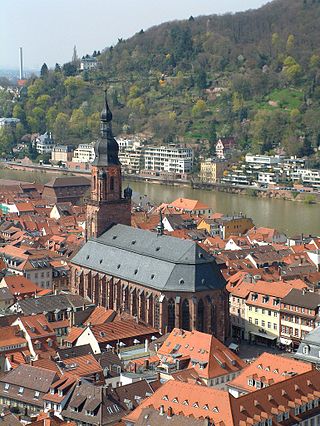
The Church of the Holy Spirit is the largest church in Heidelberg, Germany. The church, located in the marketplace in the old town center, was constructed between 1398 and 1515 in the Romanesque and Gothic styles. It receives 1–3 million guests annually, making it among the most visited churches in Germany.
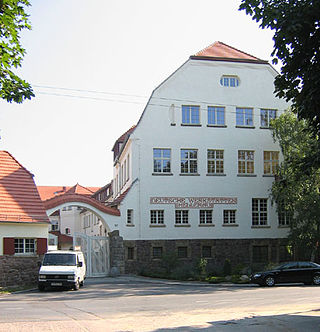
Richard Riemerschmid was a German architect, painter, designer and city planner from Munich. He was a major figure in Jugendstil, the German form of Art Nouveau, and a founder of architecture in the style. A founder member of both the Vereinigte Werkstätte für Kunst im Handwerk and the Deutscher Werkbund and the director of art and design institutions in Munich and Cologne, he prized craftsmanship but also pioneered machine production of artistically designed objects.
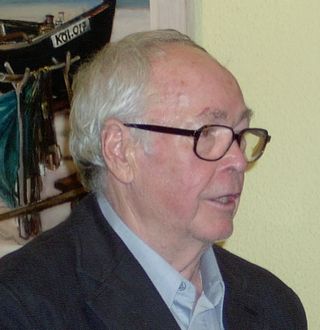
Walter Womacka was a German Socialist Realist artist. His work was pioneering early German Democratic Republic (GDR) aesthetics.
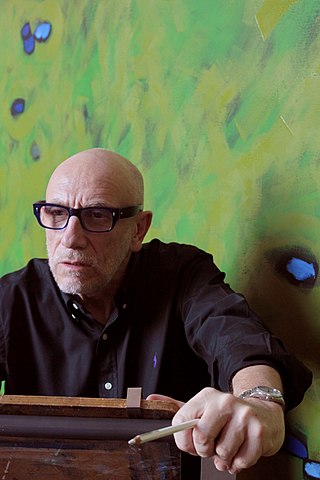
Sir Brian Clarke is a British painter, architectural artist, designer and printmaker, known for his large-scale stained glass and mosaic projects, symbolist paintings, set designs, and collaborations with major figures in Modern and contemporary architecture.

Alois Johannes Plum was an artist working in Mainz, Germany, who has acquired a national reputation for his stained glass, his paintings, and his plastic art. Plum has been active since the 1950s and his work decorates hundreds of churches and public buildings in Germany. He has created many characteristic stained glass windows in churches renovated or rebuilt after the destruction of World War II, and is especially noted for his reinterpretation of historic sacred space and his integration of glass and architecture with careful attention to the liturgical function of his art.

Josef Goller was a German designer, most notably of stained glass.
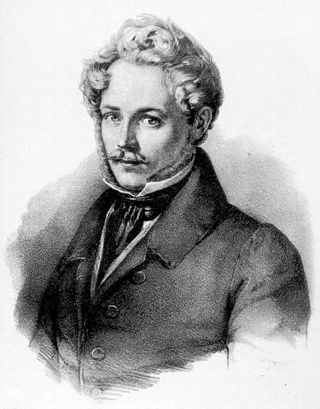
Ernst Fries was a German painter, draftsman, watercolourist, etcher, printmaker, and lithograph. Besides Karl Philipp Fohr and Carl Rottmann, he was the youngest of the so-called triumvirate of Heidelberg Romanticism. His works represent a transition from Romanticism to Realism.

Karl Philipp Fohr, a brother of Daniel Fohr, was a German painter, born at Heidelberg in 1795.
Peter Mollica is an American stained glass artist.

Henry Keazor is a German art historian. He is a professor of art history at Heidelberg University.
Michael Bacht is a German artist.

St Peter's Church is a Roman Catholic church in Cologne, run by the Jesuits. The painter Rubens was baptised in the church and his father was later buried there. Rubens' Crucifixion of St Peter is on display in the church. It was commissioned in 1638 by the Cologne art collector and businessman Eberhard Jabach and was hung in the church in 1642 after Rubens'death. The building also houses the 'Kunst-Station Sankt Peter', a centre for contemporary art, music, and literature.
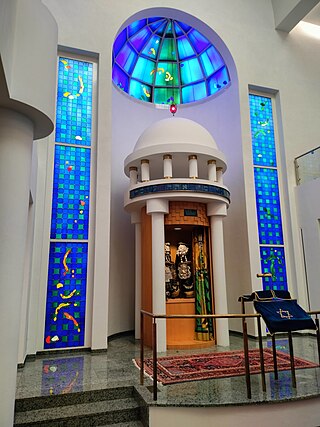
The New Synagogue is a Reform Jewish congregation, synagogue, community centre, and Jewish museum, located in Darmstadt, in the state of Hessen, Germany.
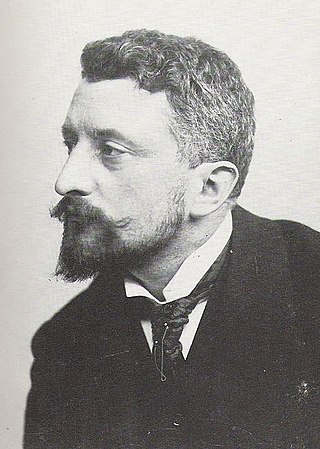
Willy von Beckerath was a German painter and art professor associated with the Düsseldorfer Malerschule. He was primarily known for portraits, landscapes and murals. From 1902, he was instrumental in the formation of the Deutsche Werkstätten Hellerau. He designed furniture and furnishings for churches. From 1907 to 1931, he was professor at the Staatliche Kunstgewerbeschule in Hamburg, where he decorated a new assembly hall with a monumental mural over three of its walls, Die ewige Welle.

Melchior Lechter was a German painter, graphic artist, and book designer.

St. Peter's Church is the oldest church in the old town (Altstadt) of Heidelberg, Germany. It has generally served as the university church of the University of Heidelberg since the late Middle Ages.